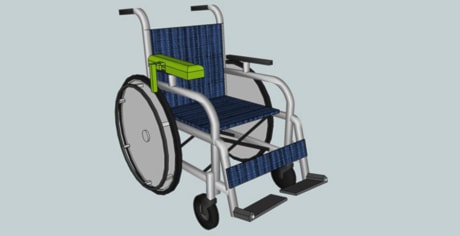Who says you have to move forward to make progress? Nicholas Schiefer has made a case for putting on the brakes instead.
When the 16-year-old high school student from Pickering, Ont., signed up to take part in Shad Valley, a month-long, nationwide enrichment program for high school students, he little imagined he would be facing the task of developing a product or service designed to help the country’s rapidly aging population.
The issue has dogged governments, corporations and policy-makers for longer than most Shad participants have been alive, but Schiefer and 10 of his fellow participants were tasked with presenting a fully developed solution — complete with working prototype and 30-page business plan — in just 19 days.
Several hours spent cloistered in a room on the University of British Columbia campus yielded hundreds of suggestions, but the penny didn’t drop for the enterprising teens until they hit upon the unlikely combination of memory aids and wheelchair mechanics.
“One of our group members used to volunteer in a hospital, and she used to hear the nurses constantly reminding patients to lock their wheelchairs before they stood up,” Schiefer said in a telephone interview. “We decided to develop a wheelchair braking system that would make it easier for them to remember this.”
The final product, the result of hours of work and many sleepless nights, is an armrest extension attached to a metal rod. When the occupant compresses the extension, the rod comes down and locks the wheels in place, allowing seniors to lean on the device for support without fear of falling.
Hundreds of kilometres away, a memory aid was also being produced on the University of Waterloo campus where 16-year-old Connor Seidel and his group members were grappling with the question of how to help seniors keep track of their medications.
The teen, from Baie D’Urfe, Que., near Montreal, helped design a device that helps keeps pills organized and reminds seniors when it’s time to take them.
“It kind of looks like a spice rack,” Seidel said. “It’s a revolving rectangle with 31 slots, one for each day of the month. Each slot is meant to hold one pill container, and those containers each hold five additional time slots so you can take pills at different times per day.”
The device, dubbed the MedRack, also comes with a portable watch that can be programmed to go off at given times. Users must then walk over to the device to deactivate the alarm, which will then hopefully remind them to take the appropriate pill, he said.
Seidel acknowledged the system makes demands at the beginning of each month when the pills need to be restocked, adding his group hopes to refine the idea and market it to hospitals and pharmacies where professionals could help out with the legwork.
For Jasneet Brar and her group working on the Carleton University campus in Ottawa, simplicity was their primary consideration.
The 17-year-old from Abbotsford, B.C., said her group wanted to design a product that could address the vision and mobility challenges faced by a growing number of Canadians.
Brar’s group learned early on that no ideas should ever be rejected out of hand at the brainstorming stage.
“Our idea kind of started as a joke,” Brar said. “Someone said ‘let’s make a glow-in-the-dark slipper so you can find it at night.’ We kind of went from there.”
The final product, the ComfortBright slipper, does feature glow-in-the-dark patches designed to help seniors locate the shoes easily. Other features include LED lights to help seniors see, memory foam and rubber soles for maximum foot support, and sheep-wool lining for warmth and comfort.
The group tried to use sustainable materials in the ComfortBright wherever possible, Brar added.
Even though the Shad program concludes in late July, the design challenges are not over for many of its participants.
One group from each campus, including Schiefer’s, will go on to compete for the Shad Cup later this year. The finalists will present their products to a panel of industry experts, who will choose winners in a variety of categories.
All Shad participants will be able to pitch in as the groups refine their designs and finalize their presentations.
The ongoing challenge of product development will allow Shads to maintain the friendships they forged during the month, which also saw them attend academic lectures, go on camping trips and indulge in other recreational activities, Schiefer said.
“It’s amazing to work with people who are just as capable and just as motivated as you are,” he said. “It’s the kind of experience you don’t really get anywhere else.”
